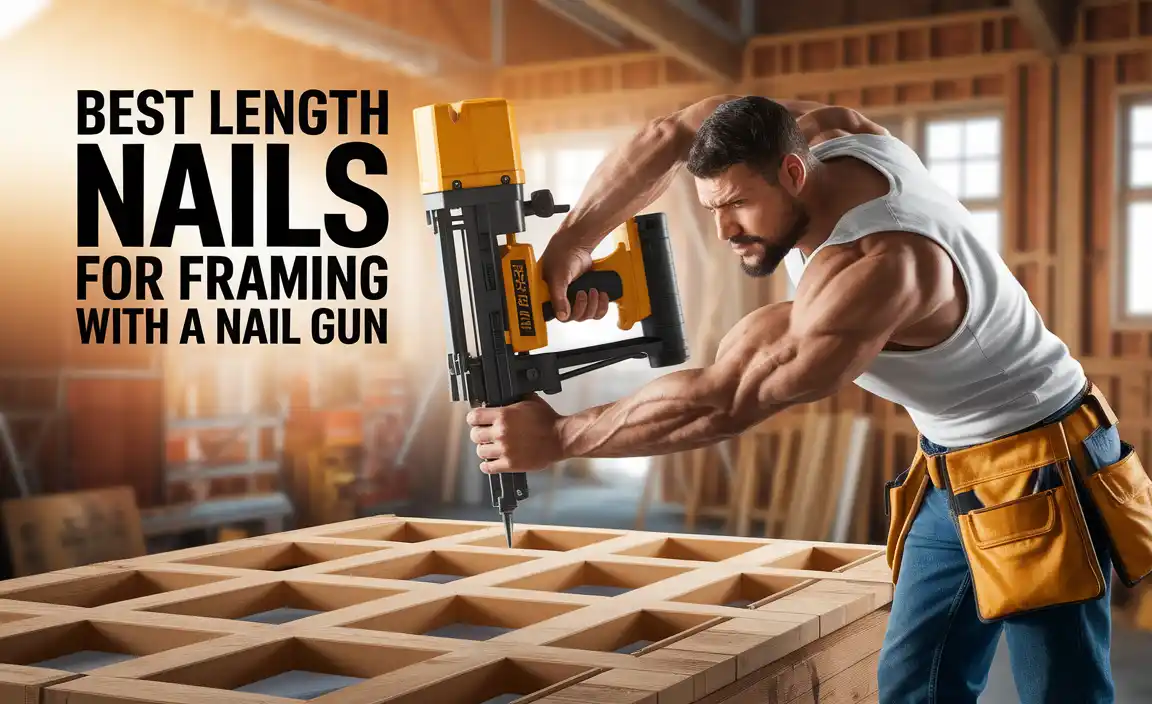Top-rated cordless nail guns make DIY projects faster and easier! For beginners, focusing on ease of use, battery life, and versatility will guide you to the perfect tool. Our expert picks cut through the confusion, helping you nail your next project with confidence.
Hey there, DIY enthusiasts and budding woodworkers! Jack Shaffer here, your go-to guy for all things nail guns. Ever stared at a pile of lumber, dreaming of building that perfect shelf or fixing up your deck, only to feel a pang of dread at the thought of wrestling with hoses and compressors? You’re not alone! That’s where a good cordless nail gun shines. It’s like having a superpower for your projects, making tasks faster, cleaner, and way more enjoyable.
But with so many options out there, choosing the right one can feel overwhelming. Don’t sweat it! I’ve rounded up some of the absolute best cordless nail guns that are making waves for their performance, reliability, and user-friendliness. We’ll dive into what makes them stand out, what types you should consider, and how to pick the one that will be your new favorite workshop buddy. By the end of this guide, you’ll know exactly which top-rated cordless nailer is destined for your toolbox!
Table of Contents
Why Cordless Nail Guns Are a DIY Game-Changer
Let’s be honest. Traditional nail guns, the ones that need an air compressor and a long hose, can be a bit of a hassle. You’ve got to drag out the compressor, hook up the hose, untangle it (why does it always get tangled?), and make sure you’ve got enough power. It’s a whole production, especially for smaller jobs or when you’re working outside or in tight spaces.
Cordless nail guns change all that. They run on battery power, meaning:
Freedom: No more tripping over hoses or being tethered to an outlet. You can go anywhere your project takes you.
Convenience: Quick setup and takedown. Grab it, pop in the battery, and you’re ready to go in seconds.
Portability: Easy to carry around the job site, up a ladder, or to a different part of the house.
Simplicity: Fewer parts mean less can go wrong, and they’re generally super easy to operate.
For homeowners tackling weekend projects or woodworkers who value efficiency, a cordless nail gun isn’t just a tool; it’s a serious upgrade that lets you focus on the fun part – building!
Understanding the Types of Cordless Nail Guns
Before we get to the top picks, it’s crucial to know the different types of nailers. They’re designed for specific tasks, and picking the wrong one can lead to frustration.
1. Brad Nailers
What they do: These use very thin, small-headed nails (brads), typically from 18-gauge to 16-gauge.
Best for: Delicate trim work, baseboards, crown molding, small cabinetry, attaching delicate molding. They leave a tiny hole that’s easy to fill.
Why you might need one: For detailed finish work where you don’t want to see nail marks.
2. Finish Nailers
What they do: Use slightly thicker nails (15-gauge or 13-gauge) with a more visible head than brads.
Best for: Installing baseboards, window and door casing, chair rails, and other trim where a bit more holding power is needed. The nail head is small enough to be easily concealed with putty.
Why you might need one: A great all-rounder for trim work that requires a solid hold but still looks clean.
3. Framing Nailers
What they do: These are powerhouses, using larger, thicker nails (2-inch to 3.5-inch) for structural work.
Best for: Framing walls, building decks, subflooring, fences, and other heavy-duty construction jobs.
Why you might need one: If you’re building anything structural, a framing nailer is essential. Cordless versions offer incredible freedom on large sites.
4. Roofing Nailers
What they do: Specifically designed to drive large-headed roofing nails quickly and efficiently.
Best for: Installing asphalt shingles and other roofing underlayment.
Why you might need one: Essential for any significant roofing project.
5. Pin Nailers
What they do: Similar to brad nailers but use even thinner, headless pins (23-gauge).
Best for: Attaching very delicate molding, small trim pieces, or anywhere you need absolute invisibility.
Why you might need one: For ultra-fine detail work where even a brad hole is too noticeable.
For most DIY homeowners and general woodworking, a cordless Brad Nailer or Finish Nailer is usually the best place to start. Framing nailers are for more specialized, heavy-duty tasks.
Key Features to Look for in a Cordless Nail Gun
When you’re shopping for a cordless nail gun, here’s what to keep your eyes peeled for:
Battery System:
Voltage (V): Higher voltage generally means more power for driving thicker nails or working through denser materials. Common options are 18V or 20V (often labeled 20V MAX).
Amp-Hours (Ah): This tells you how long the battery will last on a single charge. Higher Ah means more nails fired before needing a recharge, which is great for big jobs.
Interchangeability: Many brands have a battery platform where one battery works with all their cordless tools (drills, saws, lights, etc.). This can save you money in the long run.
Nail Compatibility:
Gauge: As discussed above (e.g., 16-gauge, 18-gauge). Make sure it matches the type of nails you’ll be using.
Length: Check the maximum and minimum nail lengths the gun can accept.
Depth Adjustment:
Tool-Free Dial: The easiest and most common method. Lets you quickly adjust how deep the nail is driven without needing tools. Crucial for sinking nails just right or leaving them proud for certain applications.
Jam Clearing Mechanism:
Tool-Free: Most modern nailers allow you to clear jams without needing an Allen wrench. This is a huge time-saver!
Firing Modes:
Sequential Mode: Fires one nail at a time only when the trigger is fully pulled. Safer and more precise.
Contact (or Bump) Mode: Fires a nail every time the nose is pressed against the material and the trigger is held down. Faster, but requires more control. Many guns offer a switch to toggle between these.
Ergonomics and Weight:
Comfort: How does it feel in your hand? Is the grip comfortable for extended use?
Balance: A well-balanced tool is less fatiguing.
Weight: Consider this, especially if you’ll be working overhead or for long periods.
LED Light: Handy for illuminating your work area, especially in dim lighting.
Belt Hook: A useful feature for hanging the nailer on your belt when moving around the job site.
Top-Rated Cordless Nail Guns: Expert Picks for DIYers
Alright, let’s get down to business! Based on my experience and what’s getting rave reviews from pros and serious DIYers, here are some top-rated cordless nail guns that consistently hit the mark. We’ll focus on brad and finish nailers, as they’re the most versatile for home projects.
1. DeWalt 20V MAX XR Cordless Brushless 18-Gauge Brad Nailer (DC618K/DC618B)
DeWalt is a name synonymous with reliable power tools, and their cordless nailer line is no exception. This 18-gauge brad nailer is a favorite for its consistent performance and ease of use.
Pros:
Excellent power for sinking 1-3/4″ brad nails into hardwoods.
Brushless motor for longer run-time and durability.
Tool-free depth adjustment and jam clearing.
Consistent firing without excessive recoil.
Reliable battery system (part of the 20V MAX line).
Cons:
Can be a bit heavier than some competitors.
Pricier than entry-level models.
Best For: Finish carpenters, cabinet makers, and serious DIYers who demand precision and power for trim, molding, and small projects.
2. Milwaukee M12 FUEL 16-Gauge Straight Brad Nailer (2550-21CT)
Milwaukee’s M12 FUEL line offers impressive performance in a compact form factor. This 16-gauge brad nailer is incredibly lightweight and boasts some smart features for quick work.
Pros:
Very compact and lightweight, making it ideal for overhead or tight spaces.
FUEL technology (motor, battery, electronics) offers excellent power and efficiency.
Drives nails consistently without needing a gas cartridge or compressor.
Tool-free jam clearing and depth adjustment.
Narrow nose profile for great visibility.
Cons:
Limited nail length capacity compared to some 18V tools.
The M12 battery platform, while great for compact tools, may not be the same as your primary M18 tools.
Best For: Cabinet installers, trim carpenters, and DIYers who prioritize a lightweight, maneuverable tool for detailed trim work.
3. Ryobi ONE+ 18V Cordless 16-Gauge Straight Nailer (P320)
Ryobi is known for its accessible price point and broad ONE+ battery system. This 16-gauge nailer is a fantastic entry-level option for homeowners.
Pros:
Affordable price point.
Uses the highly popular and affordable Ryobi ONE+ battery system.
Good power for most DIY tasks and common trim.
Simple operation with tool-free jam clearing and depth adjustment.
Lightweight design.
Cons:
May struggle with very dense hardwoods.
Less consistent than higher-end professional models.
Best For: Homeowners taking on a variety of DIY projects, from baseboards and picture frames to light repairs. A great value buy.
4. Metabo HPT (Hitachi) 18V Brushless 16-Gauge Cordless Straight Nailer (NT1855DP4)
Metabo HPT (formerly Hitachi) offers robust tools that often fly under the radar but deliver exceptional performance. This 16-gauge nailer is known for its power and reliability.
Pros:
Impressive power, capable of driving 2.5″ nails into hardwoods.
Brushless motor for efficiency and longevity.
Excellent weight distribution and ergonomics.
Tool-free depth adjustment and jam clearing.
Often comes with a good capacity FUEL cell (air spring system) for consistent power.
Cons:
Battery can add significant weight.
May be slightly harder to find locally compared to DeWalt or Milwaukee.
Best For: Professionals and dedicated DIYers who need a powerful and reliable nailer for extended trim work and various projects.
5. BOSTITCH 18V Cordless 18-Gauge Brad Nailer (BTFP71876)
BOSTITCH is another brand with a strong reputation in the fastening world. Their cordless offerings aim to blend professional performance with user convenience.
Pros:
Good balance of power and size.
Reliable performance for most 18-gauge nailing tasks.
Tool-free depth adjustment and jam clearing.
Durable construction.
Cons:
Battery life can be average compared to some top-tier competitors.
Might be on the heavier side for some users.
Best For: General DIY, trim installation, and home repair where a dependable brad nailer is needed.
Cordless Nail Gun Comparison Table
To help you visualize the differences, here’s a quick comparison of some of the top contenders. Prices vary, so consider this a general guide!
| Feature | DeWalt 20V MAX XR 18-Ga Brad Nailer | Milwaukee M12 FUEL 16-Ga Brad Nailer | Ryobi ONE+ 18V 16-Ga Straight Nailer | Metabo HPT 18V Brushless 16-Ga Straight Nailer |
| :—————- | :———————————- | :———————————– | :————————————- | :———————————————– |
| Gauge | 18-Gauge | 16-Gauge | 16-Gauge | 16-Gauge |
| Nail Length | Up to 2″ | Up to 1-1/2″ | Up to 2″ | Up to 2-1/2″ |
| Motor Type | Brushless | Brushless | Brushed | Brushless |
| Battery System| 20V MAX | M12 | ONE+ 18V | 18V |
| Key Strength | Power, Consistency, DeWalt Ecosystem | Compactness, Lightweight, M12 power | Affordability, Ryobi Ecosystem | Power, Durability, Fastener Depth Control |
| Ideal For | Hardwoods, Pro Trim, DIYers | Fine Trim, Overhead, Tight Spaces | Beginner DIY, Homeowners | Pro-Grade DIY, Heavy Trim Work |
| Estimated Price| $$$ | $$$ | $$ | $$$ |
(Price estimates: $ = under $100, $$ = $100-$200, $$$ = $200+)
How to Choose the Right Cordless Nail Gun for YOUR Project
Picking the perfect nail gun is all about matching the tool to your needs. Here’s a simple decision tree:
1. What kind of projects will you be doing MOST often?
Delicate trim, molding, picture frames: Go for an 18-gauge (or even 23-gauge pin nailer if super fine detail is key).
Baseboards, door casing, chair rails, medium-duty trim: A 16-gauge finish nailer is usually the sweet spot.
Framing walls, decks, fences: You’ll need a cordless framing nailer.
Roofing: A dedicated cordless roofing nailer.
2. What materials will you be working with?
Softwoods (pine, fir): Most nail guns will handle these with ease.
Hardwoods (oak, maple): You’ll want a more powerful nail gun, often 18V or 20V, with a strong motor.
Engineered wood or MDF: Generally fine for most nailers, but consistency is key.
3. Do you already own tools from a specific brand?
If you’re invested in DeWalt’s 20V MAX system, a DeWalt nailer makes sense for battery compatibility. Same for Milwaukee (M12 or M18), Ryobi (ONE+), etc. This can be a significant cost saver!
4. What’s your budget?
Ryobi and some other brands offer great value for beginners.
DeWalt, Milwaukee, and Metabo HPT often represent higher upfront costs but offer superior durability and performance that can be worth it for frequent use.
5. How important is weight and maneuverability?
For a lot of overhead work or tight spaces, the Milwaukee M12 FUEL series often gets the nod for being exceptionally light and compact.
Using Your Cordless Nail Gun Safely
Safety first, always! These tools are powerful. Here are the golden rules:
Read the Manual: Seriously, take five minutes to skim through your nailer’s manual.
Wear Safety Glasses: This is non-negotiable. Always, always wear eye protection.
Never Point It at Yourself or Others: Treat it like a loaded firearm.
Engage Sequential Mode for Precision: If you’re just starting, or placing a nail carefully, use sequential mode. It prevents accidental firings.
Keep Fingers Off the Trigger: Until you’re ready to fire, keep your finger completely off the trigger.
Be Aware of Your Workpiece: Don’t fire a nail into thin air or at a very sharp angle. It can cause the nail to ricochet.
Disconnect Battery When Not in Use: For safe storage and when performing maintenance or clearing jams.
* Understand Depth Adjustment: Make sure you’re not over-driving or under-driving nails. A nail head slightly proud might be desired sometimes, but generally, you want it flush or slightly countersunk.
Frequently Asked Questions
Q1: Do cordless nail guns need batteries?
A1: Yes, they run on rechargeable lithium-ion batteries. The voltage (like 18V or 20V) and amp-hour (Ah) rating determine the power and how long they last on a charge.
Q2: What’s the difference between a brad nailer and a finish nailer?
A2



